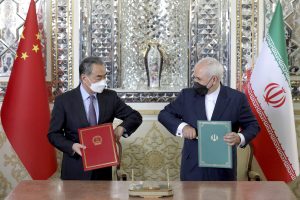On March 27, Iran and China signed a 25-year strategic cooperation agreement addressing economic issues amid crippling U.S. sanctions on Iran, state TV reported.
The agreement, dubbed the Comprehensive Strategic Partnership, covers a variety of economic activity from oil and mining to promoting industrial activity in Iran, as well as transportation and agricultural collaborations, according to the report. The deal also supports tourism and cultural exchanges. It comes on the 50th anniversary of the establishment of diplomatic relations between China and Iran.
No additional details of the agreement were revealed as Iran’s Foreign Minister Mohammad Javad Zarif and Chinese counterpart Wang Yi took part in a ceremony marking the event. Wang was in Iran as part of a broader six-country tour of the Middle East, which also included stops in Saudi Arabia, Turkey, the United Arab Emirates, Bahrain, and Oman.
The deal marked the first time Iran has signed such a lengthy agreement with a major world power. In 2001, Iran and Russia singed a 10-year cooperation agreement, mainly in the nuclear field, that was lengthened to 20 years through two five-year extensions.
Before the ceremony on Saturday, Wang met Iranian President Hassan Rouhani and special Iranian envoy in charge of the deal Ali Larijani. “No matter how the world situation changes, China’s willingness to develop China-Iran relations will not change,” Wang told Rouhani, according to a summary from China’s Foreign Ministry. He added, “… The comprehensive cooperation plan signed today will make an overall plan for promoting the China-Iran comprehensive strategic partnership.”
Wang also made pointed comments about “unreasonable unilateral sanctions imposed on Iran” and “the evil consequences of external interference on the regional situation,” clear references to the United States’ policy toward Iran.
Saeed Khatibzadeh, spokesman for Iran’s Foreign Ministry, called the agreement “deep, multi-layered, and full-fledged” the day before the signing.
The deal was first discussed during Chinese President Xi Jinping’s visit to Tehran in 2016, when he met with Iran’s Supreme Leader Ali Khamenei. But the planned agreement came under intense scrutiny last summer, when a supposed draft of the deal leaked. The documents claimed China was prepared to invest $400 million in Iran over the deal’s 25-year term, in exchange for unprecedented access to Iranian ports and islands. That, in turn, sparked fears of lost sovereignty among Iranians, where Chinese investment is a sensitive issue.
Importantly, the reported $400 million figure was not actually featured in the official announcements of the deal signed on Saturday, though it appeared in several foreign media reports. In fact, when Chinese Foreign Ministry spokesperson Zhao Lijian was pressed on the total amount of Chinese investment he refused to answer.
“The plan focuses on tapping the potentials in economic and cultural cooperation and charting course for long-term cooperation,” Zhao said. “It neither includes any quantitative, specific contracts and goals nor targets any third party, and will provide a general framework for China-Iran cooperation going forward.”
In other words, there may be less than meets the eye in the agreement, at least in its current form. Bill Figueroa, a researcher specializing in China-Iran relations, argued in a Twitter thread that the agreement was “not a big deal.” Instead, it’s “an aspirational document” that “provides no methods for enforcement, measurable goals, or specific programs.” On the defense side in particular, the specific areas for cooperation “are all things that already exist,” he noted, and are well inside the norm of China’s engagement with other regional powers.
China’s investment in Iran tells a similar story. According to the China Global Investment Tracker, China’s investment in Iran from 2010 to 2020 amounted to $18.2 billion. During the same period, China invested $30.6 billion in Saudi Arabia and $29.5 billion in the UAE. While Beijing and Tehran find political benefits in touting their relationship, the actual results lag behind Chinese engagement with Iran’s Gulf rivals.
“In short, this agreement represents an attempt to bring Sino-Iranian relations back in line with the rest of the Middle East, rather than expansion of beyond the norm for China’s engagement with the region,” Figueroa concluded.
The devil, as always, is in the details, and those apparently remained to be ironed out, in the form of specific contracts and plans for cooperation. Despite the fanfare surrounding the agreement, something is still holding China-Iran relations back – whether that’s Chinese reluctance to tangle with Iran’s sanctions-ridden economy, Iranian fears of lost sovereignty, the complex geopolitics of the Middle East, or a combination of all three.
Reportedly, Iran and China have done some $20 billion in trade annually in recent years. That’s down from nearly $52 billion in 2014, however, because of a decline in oil prices and U.S. sanctions imposed in 2018 after then-President Donald Trump pulled the U.S. unilaterally out of a nuclear deal between Iran and world powers, saying it needed to be renegotiated.
Iran has pulled away from restrictions imposed under the deal under those sanctions in order to put pressure on the other signatories — Germany, France, Britain, Russia and China — to provide new economic incentives to offset U.S. sanctions.
With reporting from the Associated Press in Tehran, Iran.

































